Bayer R.G. Mechanical Wear Fundamentals and Testing, Revised and Expanded
Подождите немного. Документ загружается.


Using Eq. (9.16), this wear test then provides a means of predicting wear in an application
for which the model is valid (i.e., where there is adequate simulation)
v ¼
WR
test
PV
test
LS ð9:16Þ
where L and S are the load an d sli ding distance in the application. Variation of K as a
function of PV, velocity, and load can be addressed by testing at different velocities
and loads. Similar approaches can be used for other test configurations. In general,
the requirement for this to be done is that the test method associated with these either
have to result in a wear rate or wear curve or be modified to provide one or the other.
While this test can be used with materials other than plastics, the specific values of
the test parameters and dimensions of the specimens are likely to be different. One reason
for this is to provide simulation since the loads and speeds in D3702 were selected to simu-
late typical conditions involving the use of plastics. Another reason is to insure proper
break-in. Generally, metals and ceramics are stiffer than plastics and, as a result, initial
alignment requirements are tighter. Also, different types of materials respond differently
to different types of break-ins. For example, it might be necessary to break-in the surfaces
with an increasing load, rather than at the test load, as is done in some versions of the
block-on-ring test. A thir d reason is that with other material pairs the coefficient of fric-
tion can be much higher than with self-lubricating materials. This can influence heating
effects and the design of the apparatus. Tests with dry, clean, metal surfaces will generally
require a much more rugged design or the use of smaller specimens and lighter loads.
9.2.14. Hostile Environment Ceramic Tests
When pin-on-disk or reciprocating pin-on-flat tests are applied to the evaluation of
ceramics, the test apparatus and procedure are generally more complex than with other
materials. This is basically because the tests are frequently done in controlled and
varied atmospheres and at elevated temperatures. For this, the apparatus must then
include an atmospheric chamber, heating elements, and a means of controlling and
monitoring atmospheric composition, and temperature. The apparatus also has to be
designed so that sliding and loading can be provided and controlled with the specimens
being inside a chamber. In addition, the apparatuses normally have friction measure-
ment capability, since the monitoring of the friction behavior during the test is typically
done with this type of material.
Testing in unique atmospheres and at elevated temperatures is done to simulate the
conditions under which ceramics are frequently used. Such simulation is required since
ceramics are reactive at elevated temperatur es and it has been found that their wear
and frictio n behavior are very strongly influenced by these reactions, as well as by surface
layers of various types. Since the coefficient of friction associated with these materials is
also affected the nature of the surface layers formed and changes in reactions, it is gener-
ally desirable to monitor friction in these tests as well (49–53). As has been pointed out
in Chapter 5 on friction, such monitoring of friction behavior is generally useful in
understanding wear behavior.
In addition to the simulation of temperature and atmosphere in these pin-on-disk
tests, the values of the other parameters, such as load, stress, speed, and material prepara-
tion, are also selected to provide simulation. With this degree of simulation the pin-on-disk
tests provide a convenient way of identifying and studying major wear phenomena
Copyright 2004 by Marcel Dekker, Inc. All Rights Reserved.
associated with ceram ics (54). While this is the case, the degree of simulation that is
typically achieved in these tests is usually not sufficient for the results to be directly applied
to an application. First-order simulation is typical of these tests because of the impossi-
bility with a simple pin-on-disk test of completely simulating the complicated conditions
of temperature, environment, stress, and geometry that occur in the many of the appli-
cations for ceramics (53). As a result, these tests are frequently used as the initial portion
of a graduated testing program (50,55,56) in which pin-on-disk test is used to provide
a coarse ranking of materials and to select materials for further evaluations in more
simulative and complex tests. The results of these more simulative or robot-type tests
are then correlated with an application (56,57). For example, the pin-on-disk test can
be used to select material candidates for an engine test, which is then used to rank
materials for such an application (50).
The duration of the tests used for ceramics varies from a few minutes to several
hours. The volume of wear that is produced during this time period is often used
directly as the measur e of the wear performance. In some cases, this is converted to a
wear rate by dividing by time or to a wear coefficient by dividing by the product of
the load and distance of sliding. Either of these is then used to rank materials. In addi-
tion to these quantitative measures of wear, the surfaces are typically examined in a
variety of ways to identify reaction products, films, cracks, and morphological features.
In some cases, the results of these examinations are used to rank material performance,
either in conjunction with the quantitative measurements or by themselves. Which
approach is used, as well as the duration of the test, is usually determined by the infor-
mation that is desired from the test, the properties of the materials, and the nature of
the wear behavior found. For example, the formation of a particular compou nd during
sliding might be the selection criteria for a higher level test and it is necessary to deter-
mine whether or not this occurs. In another case, it might be the comparison of wear
rate that is of interest. The observations and measurements made in conjunction with
these tests are not confined to the pin but are done for both surfaces.
The normal procedures, practices, and elements that are associated with the proper
performance of a pin-on-disk or reciprocating pin-on-flat test are applicable to the testing
of ceramics. Because of the more complex nature of these tests and the unique nature of
ceramics, certain elements deserve additional focus. One aspect is that there are usually
more elements to control and monitor in tests with ceramics. In addition to environmental
factors, material processing and preparation steps are often major factors in these cases.
For example, since moisture can be a significant factor in wear and friction behavior of
ceramic surfaces, a bake or drying step is usually recommended as part of the cleaning pro-
cess (49). Another example of this type of concern is with the machining and finishing pro-
cesses used. Because of the brittle nature of ceramics, their wear behavior is significantly
influenced by the presen ce of micro-cracks or residual strain in the surface region. As a
result, processes, which tend to produce such damage, should be avoided or properly con-
trolled. If they cannot be avoided, care should be taken to either redu ce the amount of
damage to an insignificant level or to control it sufficiently that consistent behavior is
obtained. Because of these additional concerns, it is usually desirable to develop a refer-
ence test which utilizes a well-controlled ceramic and to use it to monitor overall test con-
sistency. Furthermore, the information that is reported with the data should include
information regarding these additional elements, such as the specific atmospheric and tem-
perature conditions of the tests, preparation procedure, and initial condition of specimens.
Also it is not only desirable to utilize friction measurements and additional forms of
surface analysis in conjunction with these tests but also to report this information as well.
Copyright 2004 by Marcel Dekker, Inc. All Rights Reserved.

As with all tests which utilize a pin with a curved surface, the stresses change with
wear in ceramic pin-on-disk tests and can result in nonlinear wear curves or behavior.
There can be a unique aspect to this complication with ceramics. With the initial point
contact geometry of these tests, significant subsurface stresses exist to a depth comparable
to the diameter of the contact area. It is possible for cracks to develop in this region. With
growth, these cracks will result in the formation of large wear particles. As the wear pro-
gresses, the contact geometry changes from a point to a conform ing contact, with the
result that subsurface stress is reduced. Cracks will now tend to form on and closer to
Figure 9.52 Examples of initial and long-term ceramic wear scar morphology in pin-on-disk tests.
‘‘A’’ illustrates the relatively coarse features that can occur initially. ‘‘B’’ illustrates the morphology
associated with larger amounts of sliding. (‘‘A’’ from Ref. 121; ‘‘B’’ from Ref. 122; reprinted with
permission from ASME.)
Figure 9.53 Configuration of the three pin-on-disk test used for ceramics.
Copyright 2004 by Marcel Dekker, Inc. All Rights Reserved.
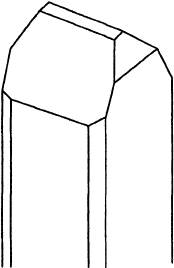
the surface and the resultant wear particles will be smaller. The effect of this is on wear is
illustratedinFig.9.52
. The formation of large initial wear particles can influence wear
behavior in two ways. One effect is an initial high wear rate as a result of wear taking place
in the form of larger particles. This is a short-ran ge effect and can easily be taken into
account by dividing the wear behavior into initial and stable regions. A second effect influ-
ences long-term behavior and is more difficult to address. This can occur by these large
wear fragments staying in the contact area and influencing subsequent wear behavior.
Another possibility is that the surface morphology, which is produced in this initial period,
toinfluencesubsequentwear,suchasthrougharoughness
effect. Such effects on long-
term behavior can have significant impact in terms of the degree of simulation that can
be achieved. A test, where these effects occur, would not be expected to correlate well with
an application, which does not experience such an initial period.
One way of approaching this type of concern is to use a combination of load and
radius such that the initial subsurface stress is below those needed for crack formation;
another way is to modify the contact geometry. Two approaches that have been used
involve a modification of the pin-on-disk test to provide better simulation. One
approach, whi ch is used to simulate piston ring applications for ceramics, involves the
useofthreeflatpinsinsteadofoneroundedpin(50)(Fig.9.53
). In this test, the pins
simulate the ring and the disk simulates the cylinder. With this test, a break-in period
is used, prior to taking data, which is typical of all tests which use a flat-on-flat contact.
A second type of modification is for the use of ceramics as cutting tools (55). In this
case,theendofthepinhasashapesimulatingacuttingtool(Fig.9.54
). Typically, with
these modified tests, measurement and analysis techniques are the same as of those used
with the more standar d pin-on-disk tests.
9.2.15. Liquid Impingement Erosion Tests
This type of wear is produced when jets or droplets of liquid impact a solid surface and is
similar to that produced by cavitation erosion. Wear on airplane windshields and airfoil
surfaces as a result of rain are examples of this type of wear. In this type of wear, the liquid
provides pressure pulses to the surface. A variety of wear apparatuses have been used to
evaluate materials in terms of their resistance to this type of wear. Two examples are
showninFigs.9.55
and9.56. Generally the test configurations used involve a jet impacting
Figure 9.54 Pin geometry used to investigate the wear behavior of ceramics for machining
applications.
Copyright 2004 by Marcel Dekker, Inc. All Rights Reserved.
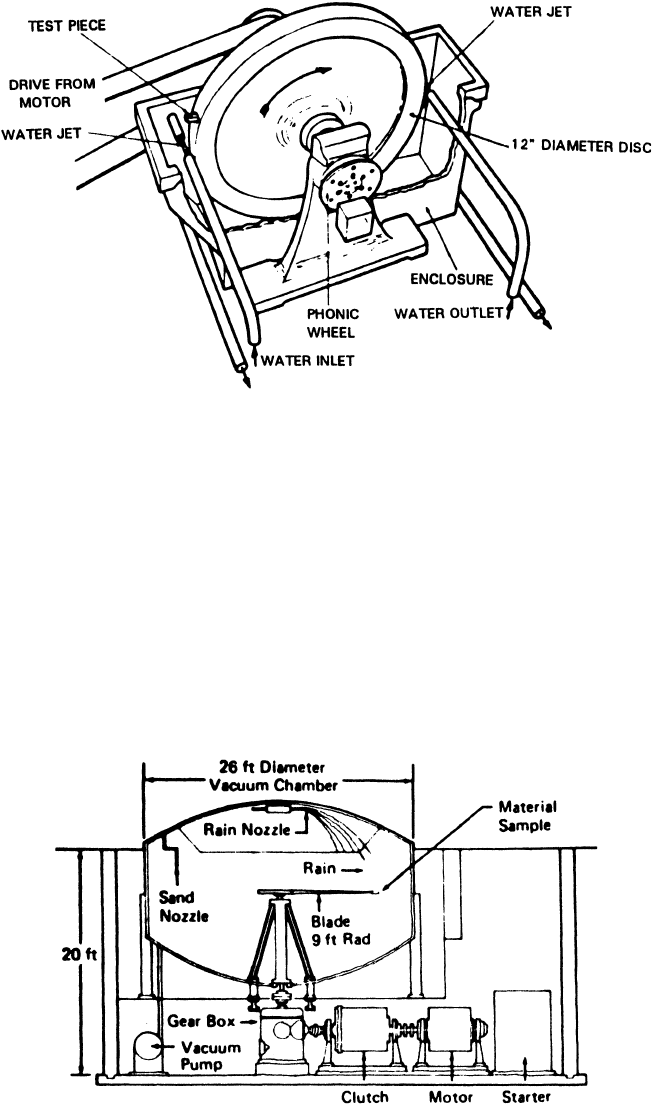
a specimen or a specimen moving through a droplet field. There are some significant
differences between these two types of tests. With jets , the impact is generally focused
on a specific region. With a droplet field, the impacts are distributed randomly over a large
area. Repetitive impact tests tend to be more severe than distributed impact tests. With
either type the recommended practice is to develop a wear or erosion curve relating
damage to time or amount of liqui d impingement. The measure of the damage varies,
depending on the nature of the materials and the function of the materials. For bulk mate-
rials, where dimensional changes are the only concern, mass loss is frequently used.
For optical applications, light transmission characteristics might be us ed.
Figure 9.55 A small, low-speed apparatus used to investigate liquid impingement erosion. (From
Ref. 122, reprinted with permission from ASTM.)
Figure 9.56 A large, high-speed apparatus used to investigate liquid impingement erosion. (From
Ref. 122, reprinted with permission from ASTM.)
Copyright 2004 by Marcel Dekker, Inc. All Rights Reserved.
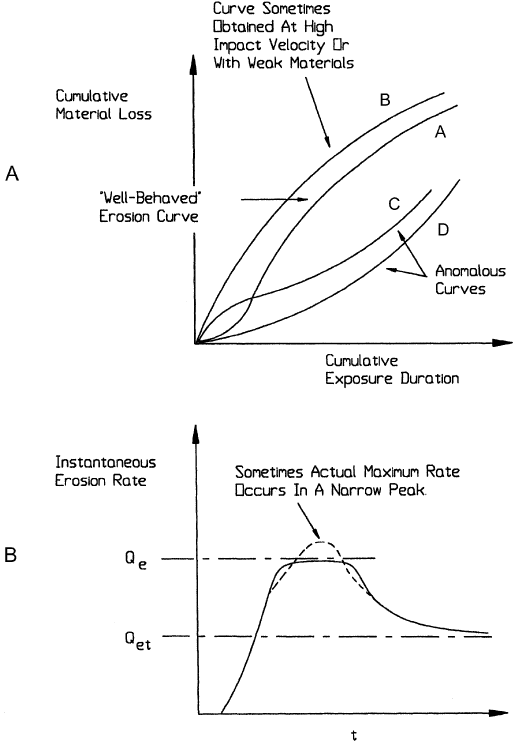
The curves that are generated in these tests are characteristically nonlinear but tend
tohaveatypicalshape,‘‘A’’inFig.9.57
A. Other possible shapes from these tests are also
illustrated in this figure. In the typical case, there is an initial incubation or low erosion
rate period. This is followed by a second region in which the erosion rate increases to a
maximum value. A third region occurs in which the erosion rate decreases to some lower,
stable value. This is illustrated in Fig. 9.57B. The durati on of the incubat ion period, the
maximum erosion rate, or the stable erosion rate are normally used for ranking
purposes. The significance and selection of each depends on the application. In optical
applications, the duration of the incubation period is more important than the rates. For
applications in which long-term behavior is important, the stable erosion rate is the most
significant. With anomalous behavior, curves ‘‘B’’, ‘‘C’’, and ‘‘D’’ in Fig. 9.57A, these
features may not be present. In this case, other aspects of the curve are used for compari-
son purposes. In these cases, maximum erosion rate or cumulative damage are the more
Figure 9.57 ‘‘A’’ shows the general from of the wear curves obtained in liquid erosion tests. ‘‘B’’
shows the typical behavior of erosion rate during the course of an erosion test. (From Ref. 123.)
Copyright 2004 by Marcel Dekker, Inc. All Rights Reserved.

commonly used feature for comparison. This method of analyzing liquid impingement
data can either be done with erosion curves that relate cumulative damage to test duration
or time or with curves that relate cumulative damage and amount of impinging liquid.
The latter approach has an advantage. When damage is correlated with cumulative
amount of impinging liquid, rather than accumulated test time, a basis for relating results
from different tests and between tests and applications can be established.
When thin coatings are evaluated in these erosion tests, it is sometimes difficult
to quantify intermediate damage and, as a result, erosion curves cannot be generated.
In these cases, time to wear-through of the coating is used. This point is determined by
monitoring the coating during the test.
A general method of conducting and analyzing these tests is given in the ASTM G73.
It is pointed out in the ASTM standard that these tests should not be carried out beyond
the point that the wear depth of the scar exceeds the width since significant changes in
impact angles tend to occur beyond this point (see Fig. 9.15.) The standard also focuses
on the need for control, discusses the information that should be reported with the
results, and recommends the use of reference materials to normalize the erosion curve
parameters. When the procedures recommended in this standard are followed it is gene-
rally found that similar rankings are obtained from different tests when the differences
in material behavior are greater than 20%. For smaller differences rankings generally
depend on the test and test parameters. General correlation is also found with applications
as well, particularly in terms of ranking or screening materials. Absolute performance is
less predictable, because of the large num ber of factors involved an d the difficulty of
describing field or application conditions associated with this type of wear.
9.2.16. Block-on-Ring Test for Plastics
A standard test method using a block-on-ring configuration has been developed for the
ranking of plastic in terms of their resistance to sliding wear, ASTM G137. While test
parameters and the configuration are different than those in thrust washer test used
to evaluate plast ics (ASTM D3702), there is good correlation with rankings obtained.
The prime advantage of G137 over D3702 is the time it takes to complete a test.
G137 is a significantly shorter test. The test method allows the use of different materials
and roughness for the ring, different loads, different temperatures or environments, and
different speeds, though a maximum speed is specified. The test procedure requires re-
porting of these parameters along with the results. In interlaboratory testing programs
the coefficient of variation ranges between 45% an d 106% with a laboratory and between
84% and 106% between laboratories.
The signi ficant difference between this test method and the more general test method
described in Sec. 9.2. 6 is that wear rate is used rather than wear volume. The test consists
of interrupting the test at intervals for measuring mass loss of the specimen and developing
a wear rate curve. A specific wear rate for each interval is computed, using the following
equation,andplottedasafunctionoftime.SuchacurveisillustratedinFig.9.58
:
WR
s
¼
1
NVr
Dm
Dt
ð9:17Þ
where WR
s
is the specific wear rate for the interval. N is the load. V is the velocity. r is the
density. Dm is the mass loss for the interval and Dt is the duration of the interval. This is
done until a steady state is reached. The steady state is defined as region in which the spe-
cific wear rate curve becomes flat with less than 30% variation in specific wear rate for the
Copyright 2004 by Marcel Dekker, Inc. All Rights Reserved.
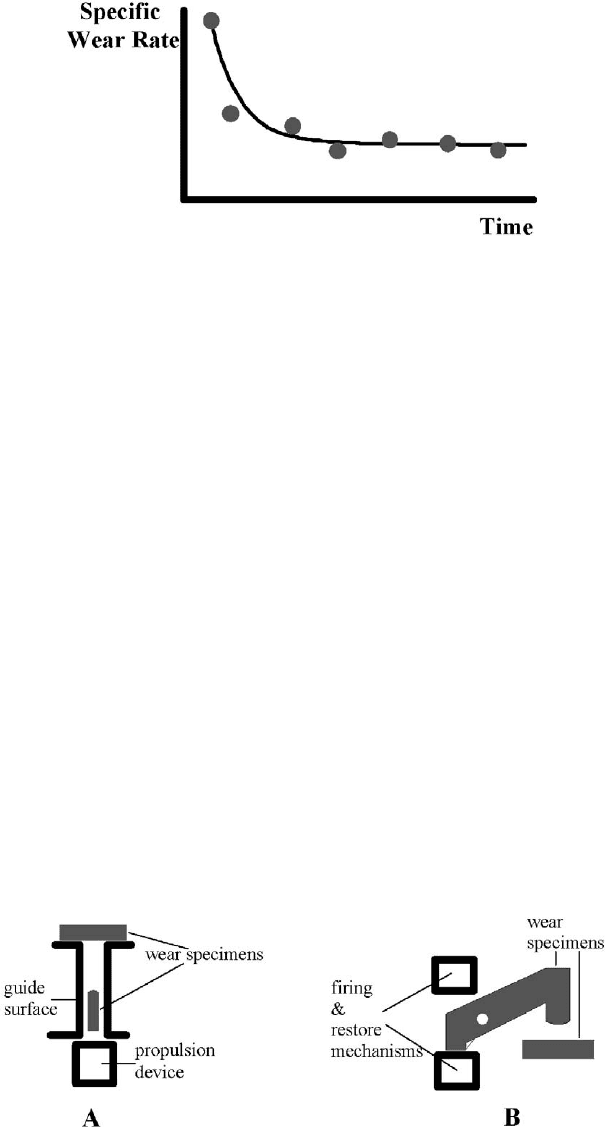
intervals. This is done using a minimum of six inter vals of which three must be in the stable
region. The method also specifies that the total test time in the stable region be a minimum
of 18 hr. The average of specific wear rates for the intervals in the stable period is then used
as the measure for characterizing the plastics wear resistance.
In this test, variations in the wear rate in the stable period can be from two sources.
One is simply from experimental variations and measurement accuracy. The other is a per-
iodic fluctuation in wear rate that some plastics exhibit in an otherwise period of stable
wear behavior. This type of behavior is called oscillating wear.
9.2.17. Impact Wear Tests
Since impact wear testing has not received the attention that sliding and rolling wear test-
ing has received, there are no broadly used tests for impact wear. However, a number of
different methods and apparatuses have been used to study normal and compound impac t
wear and to compare the resistance of materials to these types of wear (58–63). Appa-
ratuses that have been used generally can be grouped into two generic categories, pivoting
andballistic.TheseareillustratedinFig.9.59
. For simple or normal impact, that is, no
sliding involved, the flat member is stationary. For compound impact, that is, combined
impact and sliding, the flat member rotates or oscillates beneath the hammer or projectile.
With impact wear tests the wear specimen is generally softer than the counterface and can
be either the flat or the moving hammer or projectile. Testing methods and techniques
for measuring wear and comparing materials are similar to those used for sliding wear.
Figure 9.59 Schematics of ballistic (‘‘A’’) and pivoting (‘‘B’’) impact wear testers.
Figure 9.58 Illustration of a wear rate curve obtained with the polymer block-on-ring test, showing
the decrease in wear rate usually observed in this test. The points represent values of the specific
wear rate obtained for the individual test intervals.
Copyright 2004 by Marcel Dekker, Inc. All Rights Reserved.

Materials are characterized using either wear after a fixed number of impacts, wear
rates, or wear curves. Weight-loss and geometric methods are used for determining wear.
Generally the same type of parameters need to be controlled and reported with the wear
data. The number of impact usually required for these tests is large and high repetition
rates are required or at least desirable for impact wear apparatuses. The number of
impacts used in wear tests for evaluating materials for engineering applications is usually
somewhere between 10
6
and 10
8
impacts (64).
By their very nature, designs of impact ap paratuses tend to be more complex than
those used for sliding. Because of the dynamic nature of the contact in impact wear testing,
there is usually the need for greater concern with the design of the apparatus and shape of
the impactor to insure adequate repeatability. Fundamentally, this is because impact
stresses and loads are not sole determined by the momentum or energy of the hammer or
projectile. They are also affected by a number of other factors, including the geometry
of the contact, possible rotation of the projectile, and stiffness of the hammer. Fretting in
impact situations can also affect wear and is generally undesirable in impact test. Conseq-
uently, the stiffness of the apparatus can also affect wear behavior and repeatability
(65–67). While flat-surface hammers and projectiles have been used, curved surfaces are
preferred because of alignment problems.
9.2.18. Tests for Paint Films
Examples of the need to use several wear tests to evaluate materials for a wear situations
are a group of tests used to evaluate paints for automotive applications (68–70). These
tests also illustrate the use of measures other than wear volume, wear rate, or duration
for the evaluation of the wear resistance of materials. Studies of the damage found on
painted surface of external surfaces of automotive applications lead to the identification
of four modes of wear or damage. One is erosion, resulting from the impact of small
particles. The other is abrasion, where hard particles are drawn across the surface. A third,
called friction induced damage, is the pealing of the surface as a result of rubbing contact.
The fourth is an impact wear resulting from the impact of large stones . Four different tests
are used to simulate these conditions and in the evaluat ion of paints and paint systems for
these applications.
To simulate the erosion mode a solid particle erosion test is used (69). This test is
showninFig.9.60
. The metric that is used in this test for characterizing wear resistance
or erosion resistance is the mass of particles required for the removal of the coating,
Q
c
. The larger this value the more resistant the paint.
Studies have shown that this test results in the removal of the coating in a circular
spot of increasing size, as shown in Fig. 9.60B. These studies have also shown that Q
c
and r, the radius of the spot, are related by Eq. 9.18.
r ¼
h
b
ln m
h
b
ln
2ph
2
Q
c
b
2
ð9:18Þ
In this equation, h is the stand-off-distance between the nozzle and the surface, as
shown in Fig. 9.60A. m is the mass of erodent resulting in a spot of radius r. b is called
the focus coefficient, which defines the divergence of the particle stream and is dependent
on the nozzle roughness and the nature of the particles, not on the coating. By monitoring
the grow th of the radius with r with the amount of erodent, both b and Q
c
can be
determined.
Copyright 2004 by Marcel Dekker, Inc. All Rights Reserved.
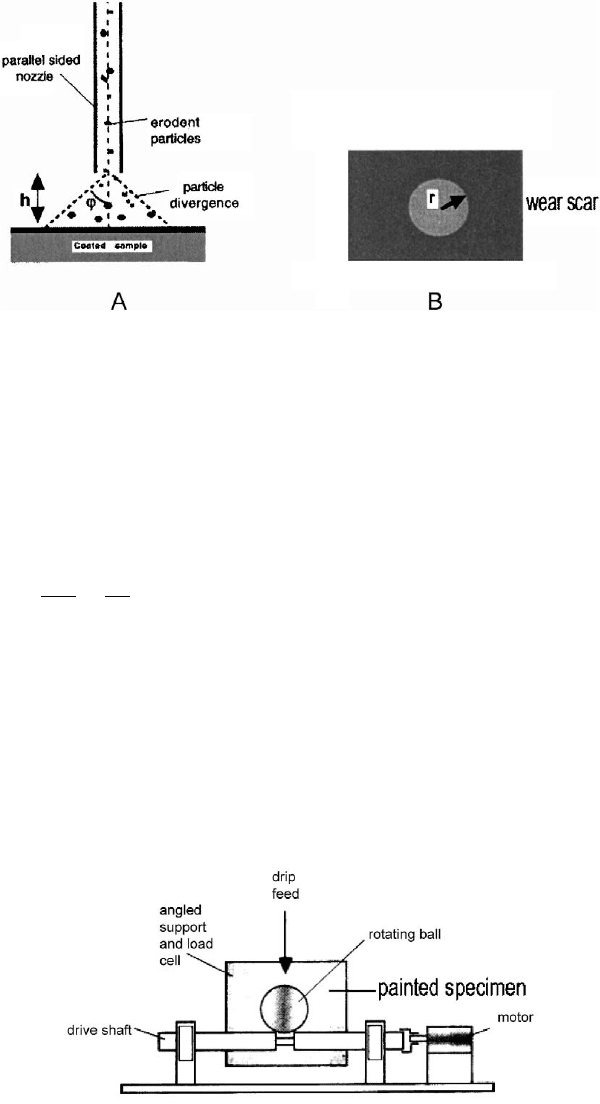
Amicro-abrasiontest,showninFig.9.61, is used to evaluate abrasive wear resis-
tance (69). In this test, a ball is loaded against the paint surface and rotated. A slurry
of abrasives is fed to the nip and abrasive particles are dragged across the painted surface.
This test results in a wear scar, which has the shape of a spherical segment of a sphere
the same size as the ball. The abrasion resistance of the surface is given by an abrasive
wear coefficient, k, defined as
k ¼
pb
4
64R
1
SL
ð9:19Þ
b is the diameter of the wear scar. R is the radius of the ball and S and L are the total
amount of sliding and the load used in the test. The smaller value of wear coefficient
the more abrasive resistant the paint.
To simulate stone impact a test apparatus was developed, which fires a projectile at a
paintedsurface(68).ThisapparatusisshowninFig.9.62
. While actual stones can be fired
with this apparatus, tests used for evaluating material generally use a standard projectile,
such as ceramic cylinders. Materials are evaluated in terms of the area of paint removal
Figure 9.61 Diagram of micro-abrasion test used for the evaluation of painted surfaces. (From
Ref. 69.)
Figure 9.60 ‘‘A’’ shows a schematic of the erosion test used to evaluate painted surfaces. ‘‘B’’
illustrates the wear scar produced in this test. (From Ref. 69.)
Copyright 2004 by Marcel Dekker, Inc. All Rights Reserved.
